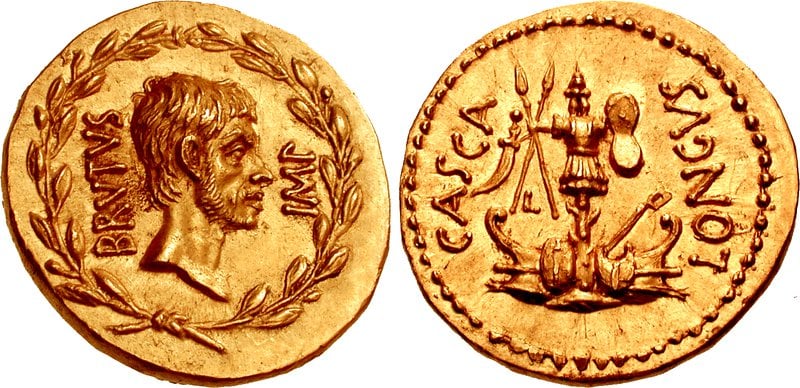Brutus Gold Coin Minted After Caesar’s Assassination Put Up For Auction
Source: GreekReporter.com

A gold coin featuring Marcus Junius Brutus, minted after he helped assassinate Roman leader Julius Caesar, has been put up for auction and will be sold next week. This incredibly rare coin dates to 43 or 42 BC. Brutus is pictured on the front, and a trophy celebrating a naval victory is carved on the back. Only seventeen of these coins are known to exist.
These are by far the rarest gold coins ever minted following the assassination of Caesar, but they were not the only ones with which conspirators paid their soldiers. Brutus also minted coins such as silver denarius coins, worth about a day’s pay, and gold aureus, roughly equivalent to a month’s salary.
How Brutus and Cassius murdered Caesar
In March of 44 BC, Brutus and Gaius Cassius led an insurrection of men to the Roman Senate. They planned to murder the emperor, Caesar, because they thought his absolute power threatened the Roman Republic.
Caesar was stabbed 23 times, and he famously said to his friend, Brutus, who was one of the main culprits involved, in Greek, “Even you Brutus?”
Popular unrest forced Brutus and his brother-in-law, fellow assassin Gaius Cassius Longinus, to leave Rome in April of the same year.
Disagreements between those involved in Caesar’s assassination and the allies of Caesar unraveled into a civil war that lasted for roughly a year from 43 to 42 BC. Brutus and Cassius attempted to lead a campaign to take eastern Roman provinces whilst Caesar’s allies remained in Rome. The war ended with the defeat of the two assassins at the Battle of Philippi in Greece. After the defeat Brutus took his own life.
The gold coin’s inscriptions celebrate Brutus’s military triumphs
According to experts, the carving on the front of the coin that reads BRVTVS IMP(erator), is a reference to Brutus’s victory against the Thracians of Bessi, who challenged Brutus’s control of the area during the war in 43 BC.
The two conjoined ship prows on the back of the coin also represent Brutus’s and Cassius’s naval victories in 42 BC. Many believe the two victories represented by the coins are the reason for the insurrectionist’s defeat in Philippi. This is because their forces were worn out after they fought on two fronts.
In addition to a reference to their victories, the back of the coin also references Publius Sevilius Casca Longus, who many believe was the first to stab Caesar.
The coin is so rare also because only six stamp dyes were used to create the design, which was quite limited in supply. The coins stem from the collection of a 20th-century Italian politician known as Giuseppe Mazzini. The particular coin of interest was last sold in 2006.
The original article: belongs to GreekReporter.com .
